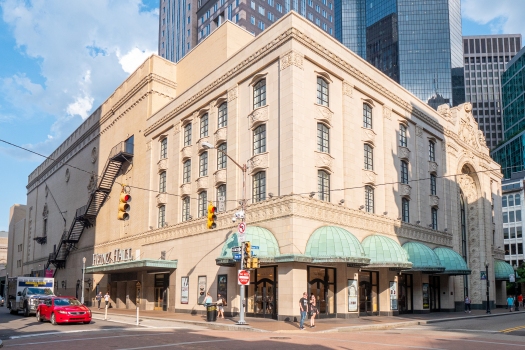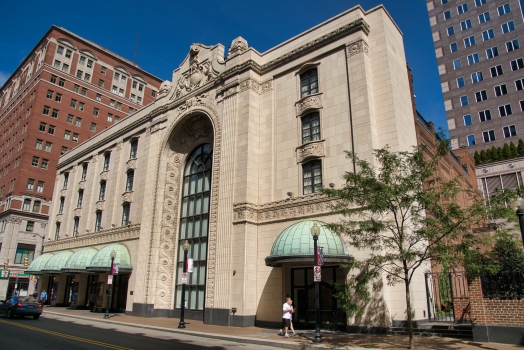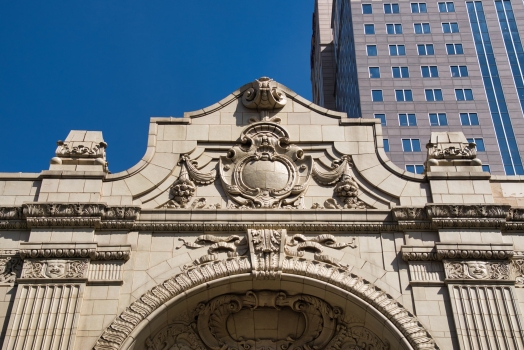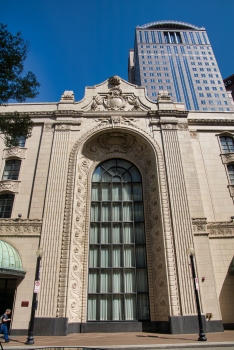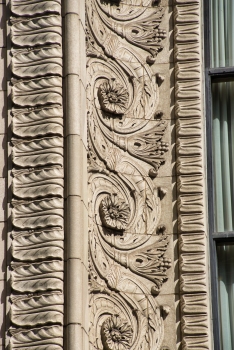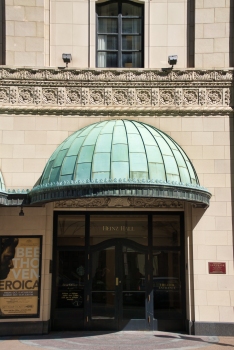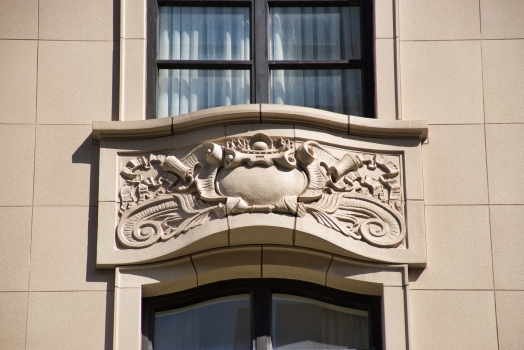General Information
| Other name(s): | Penn Theatre |
|---|---|
| Beginning of works: | 6 January 1926 |
| Completion: | 10 September 1927 |
| Status: | in use |
Project Type
| Function / usage: |
Concert hall |
|---|
Location
| Location: |
Pittsburgh, Allegheny County, Pennsylvania, USA |
|---|---|
| Address: | 600 Penn Avenue |
| Coordinates: | 40° 26' 33.49" N 80° 0' 5.48" W |
Technical Information
There currently is no technical data available.
Excerpt from Wikipedia
Heinz Hall is a performing arts center and concert hall located at 600 Penn Avenue in the Cultural District of Pittsburgh, Pennsylvania. Home to the Pittsburgh Symphony Orchestra (PSO) and the Pittsburgh Youth Symphony Orchestra, the 2,676 seat hall presents about 200 performances each year. Originally built in 1927 as Loew's Penn Theatre, the former movie palace was renovated and reopened as Heinz Hall in 1971.
History
Built as the Loew's and United Artists' Penn Theatre, construction of the building started on January 6, 1926 and was completed in 1927 on the site of the former "Hotel Anderson". Motion picture business magnate and pioneer Marcus Loew engaged the architectural firm of Rapp & Rapp to design the movie palace. The Grand Lobby was particularly impressive, with its 50-foot (15 m)-high vaulted Venetian ceiling, massive ornamental columns, marble staircase, bronze and crystal chandeliers and silk drapes.
Like many 1920s-era film palaces, Loew's Penn fell on hard times in the 1960s. Competition from television and suburban theaters along with high maintenance costs put a squeeze on profitability. The theater shut its doors in 1964 and was scheduled for demolition. Henry J. Heinz II and Charles Denby, President of the Pittsburgh Symphony Society, together with the Andrew W. Mellon Foundation, the Allegheny Conference and the Urban Redevelopment Authority of Pittsburgh, purchased the site and rescued the theater for the purpose of creating a new home for the Pittsburgh Symphony.
From 1967 to 1971, the building was extensively renovated. While the basic architecture of the building remained unchanged, the entrance was moved outwards and faced with a 40-foot (12 m)-high arched window. The one-ton chandeliers were rebuilt and their crystals replaced. The original polychrome decor was replaced by a brilliant white and gold design. Ornamental elements in the auditorium were replaced by acoustical baffles to convert the former movie theater into a lively sounding concert hall. The back of the building was extended, adding almost 30 feet (9.1 m) to the stage, and making space for dressing rooms, a music library, and rehearsal rooms.
The Grand Opening of Heinz Hall was on September 10, 1971.
In 1982, the Heinz Foundation sponsored the creation of Heinz Hall Plaza and a four-story addition to the hall.
In 1995, Heinz Hall underwent a further four-month, $6.5-million renovation, including a new orchestra shell, acoustical risers, new butterfly sound reflector, heating and air conditioning improvements, fresh paint, wallpaper and gold leaf and auditorium seats refurbishment.
Background
Heinz Hall almost never existed because plans were being made for an entire $40 million cultural complex in the Upper Hill District, above the Civic Arena. This plan fell through when a new stadium for the Pittsburgh Steelers and Pirates took top priority. The Howard Heinz Endowment paid $850,000 for the closed and vacant movie house known as Pittsburgh's "Temple of the Cinema" in 1967. The Heinz family would also fund the multimillion-dollar renovation for the performing arts center that would house all local production companies.
Henry John Heinz was an active contributor and a major force in the development of downtown Pittsburgh, particularly the Cultural District. Called a "generic philanthropist" by a friend, H. J. Heinz donated to the arts, healthcare, education, historic preservation, and was an active contributor all over the city. Carol Brown, president of the Cultural Trust said (about H. J. Heinz), "He was a man of great taste. He expected the best, and he expected his standards to be met." Heinz was an especially strong force in the arts, all while running the well-known company his grandfather founded.
Renovation
Refurbishing an old movie palace was a more practical plan compared to the enormous cost of building a new performing arts complex. Although much of the grandeur of the Loew's Penn still remains, the decor of the remodeled Heinz Hall is comparatively simple while retaining the elegant lines of the original theater. It took three years for the $10 million renovation to be completed, most of the work being done by local craftsmen and artisans. The 24-karat gold leafing alone took 18 months for two local craftsmen from the A. J. Vater Company to complete. The theater's original chandeliers were rebuilt and redesigned with new crystals. Once a year, all of the chandeliers are lowered to be cleaned and re-lamped. The orchestra pit is powered by a hydraulic lift and is able to hold 80-85 musicians. A new five story wing was also added in the back of the building. It added 25 feet (7.6 m) to the stage and has a lot more dressing rooms and soundproof rehearsal rooms. The main rehearsal room has the same dimensions as the stage, allowing the orchestra to maintain its concert seating arrangement in rehearsals. The original theater's acoustics, designed for films and vaudeville, were made more lively by the removal of heavy drapes and upholstery and the addition of acoustical baffles throughout the auditorium. The fan reflector proscenium helps project sound further, making Heinz Hall a "good throw."
The acoustics are generally excellent throughout the renovated hall with the most expensive seats in the dress circle of the balcony having the best sound. However, the premiere boxes of the Grand Tier (the deluxe mezzanine "loge" seating of the Loew's Penn) are acoustically poor for concert performances due to their position deep underneath the overhang of the balcony. Heinz Hall was a great improvement for the Pittsburgh Symphony over its previous home, the Syria Mosque, which was visually and acoustically drab. Another design feature of Loew's movie house features that makes Heinz Hall a great venue for concerts or shows is its excellent sight lines with not a bad seat in the house. In 1995 Heinz Hall underwent a further $6.5 million renovation in which new additions were made to make a visit to the theater more enjoyable.
Grand opening
William Steinberg conducted the Pittsburgh Symphony at the hall's inaugural concert on September 10, 1971. Two days later Pittsburgh Civic Light Opera (CLO) had its opening night in its fourth home. Newspaper articles on the opening are nearly impossible to find because the Pittsburgh Press was on strike at the time. Among the celebrities in town for the event were Charlton Heston, James Earl Jones, Agnes de Mille, and Gregory Peck. The dedication speech was given by H. J. Heinz II.
Additions
In February 1978, plans were announced for the construction of a garden beside Heinz Hall, and the building housing Woolworth's was soon demolished. The Garden Plaza opened May 7, 1982. During spring, summer, and early fall the Garden Café is open for lunch on weekdays. Also, during intermission guests can go out to the plaza to see the waterfall and water sculpture, Quartet by Angela Conner. Another place to have a special event is the elegant Mozart Room. A reservation is needed, but it is open for pre-show dining or a private function. The Mozart Room and the Garden Café are catered by Common Plea Catering . In 2010 sidewalk and entrance ways were improved and in the summer of 2011 the roof and moorings will be refurbished as part of an ongoing $20 million effort to renovate Heinz Hall.
Text imported from Wikipedia article "Heinz Hall for the Performing Arts" and modified on October 7, 2019 according to the CC-BY-SA 4.0 International license.
Participants
-
Rapp & Rapp
- George L. Rapp (architect)
Relevant Web Sites
- About this
data sheet - Structure-ID
20078379 - Published on:
26/09/2019 - Last updated on:
27/09/2019

